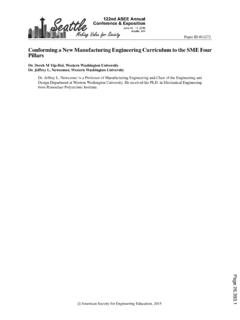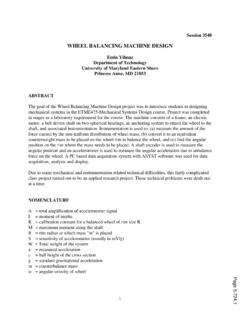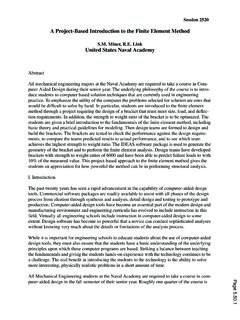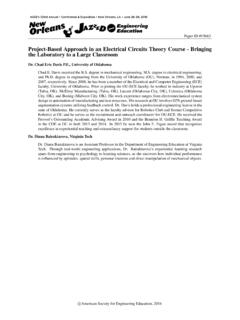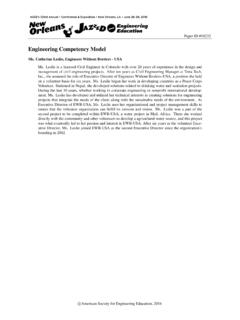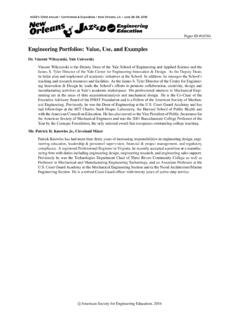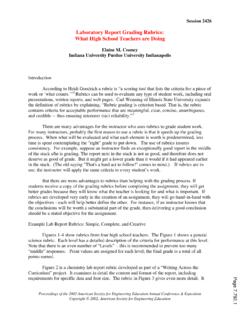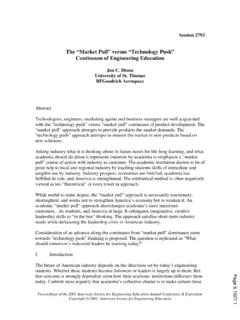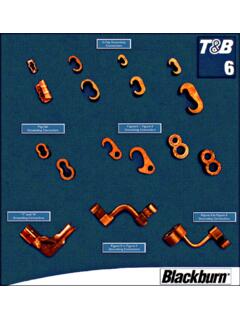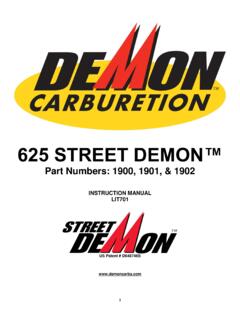Transcription of Selection Of Material, Shape, And Manufacturing Process ...
1 AC 2010-926: Selection OF MATERIAL, SHAPE, AND MANUFACTURINGPROCESS FOR A connecting rods omnath Chattopadhyay, Pennsylvania State University American Society for Engineering Education, 2010 Page Selection of Material, Shape and Manufacturing Process For a connecting Rod ABSTRACT This activity centers on the courses of strength of materials and production design offered at a sophomore level Mechanical Engineering curriculum. A connecting rod is one of the most mechanically stressed components in internal combustion engines. The objective of the activity is to select the appropriate material for a connecting rod where the constraints are to make the product as light and cheap as possible and yet strong enough to carry the peak load without failure in high cycle fatigue. The fracture toughness also needs to be above a certain minimum value.
2 A further requirement is that the connecting rod should not buckle during operation. These constraints are used to select an appropriate cross section and material for construction. The next phase involves the Selection of Manufacturing Process for which the constraints are shape, mass, quality and economics. The selections of the material, the cross-sectional shape and the Manufacturing processes involve the use of CES EduPack, which yields materials that meet the constraints. The current Manufacturing processes for connecting rods by fracture split drop forging and fracture split powder forging are highlighted and compared based on current information. INTRODUCTION A connecting rod in a high performance engine is subjected to inertial forces and bearing loads. It should be able to withstand these forces for a large number of cycles.
3 In order to reduce the forces exerted during operation, the connecting rod should weigh as little as possible and should have very high fatigue strength. The connecting rod undergoes cyclic tension, compression as well as bending. The connecting rod is subjected to a combination of axial and bending stresses. Furthermore the connecting rod is subjected to a large compressive load so that it is imperative that buckling does not occur. To mitigate this problem, I - section is commonly used. A further consideration involves the shape of the cross-section. When a structural member is subjected to an axial tension the area of the cross-section is important but the shape is not. All sections with the same area will carry the same load. For bending, an I -section is better than a solid section of the same cross-sectional area.
4 To characterize this, we need a metric a way of measuring the structural efficiency of a section shape, independent of the material which the connecting rod is made of. We define the shape factor of a section as the ratio of stiffness or strength of the shaped section to that of a neutral reference shape typically a solid square cross-section with the same cross-sectional area. The material Selection as influenced by the shape is outlined in this work. The Selection is also based on the application of an additional standard constraint that the fracture toughness should exceed 15 MPa m. In order to select the proper Manufacturing Process , the economic, technical and quality constraints are employed. The economic constraints involve raw material cost and batch size used in production.
5 The technical constraints consist of estimated connecting rod mass and a minimum section of the connecting rod. The quality constraints involve Manufacturing tolerance Page and surface roughness. The competitive processes of powder methods and forging are carefully investigated tracking the latest developments in alloy development. Ashby (2005) has indicated a procedure for Selection of material for a connecting rod based on the constraints of high cycle fatigue and elastic buckling and has concluded the alloys of magnesium, titanium, beryllium and aluminum as potential choices for connecting rod materials. Ashby, Shercliff and Cebon (2008) have identified high strength magnesium, aluminum and ultra high strength steels as attractive candidates for connecting rod materials based on the constraints of high cycle fatigue and fracture toughness.
6 They have also refined the search on connecting rod materials and identified aluminum reinforced with silicon carbide, boron or alumina fibers, beryllium alloys and a number of high performance carbon reinforced composites. Farag (2002) has listed some of the general (not specific to connecting rod) material performance requirements and has related possible modes of failure with the material properties. He states that the catastrophic fracture due to impact loading is resisted by the high fracture toughness, which is a rigid material requirement and should be used for initial screening of materials. He also states that the local and the global buckling are resisted by high elastic modulus, and is a soft material requirement. Ashby, Shercliff and Cebon (2008) have looked at the shaping of a steel connecting rod and have arrived at the short list of processes as (a) die casting, (b) forging and machining, and (c) powder methods and machining.
7 They have concluded that for a production batch size of 10,000, forging comes out the cheapest followed closely by die-casting. They point out that powder methods are more expensive because of slower production rate and high capital cost. According to Ilia et al (2005) there are at the present time two processing technologies available to manufacture connecting rods : fracture-split drop forging and fracture-split powder forging. There are some contradictory results reported in the literature regarding the strength of connecting rods manufactured through powder forging and drop forging. Afzal and Fatemi (2004) claim that the fatigue strength of drop forged connecting rod is higher than that of a powder forged connecting rod. However, Ilia et al (2005) maintain that the reverse is true and that higher performance, superior raw material utilization and lower total cost of the finished machine and assembled product are the main reasons why the use of powder forged connecting rods has significantly increased in the last two decades, taking away the market share of drop forged connecting rods .
8 The students in the courses of strength of materials as well as production design use CES EduPack (2009) software as a design-led procedure for selecting materials and processes. MATERIAL Selection If A denotes the area of cross-section of the connecting rod and L its length and the density of the material of which it is made then the mass m is: Page )1( ALm If the applied force on the connecting rod is F and the endurance limit of the material as e , the fatigue constraint requires that, )2(/eAF The mass from equation (1) by eliminating A is then given by, )3()(eFLm In order that the mass is minimized we need to maximize the material index, M.
9 4(1 eM Creating a chart with e and as axes and applying an additional constraint that the fracture toughness exceeds 15 MPa m identify materials with high values of this index. This is the Selection Process for direct tension or compression load on the connecting rod. The Selection is shown in Figure 1 and uses the Level 2 Materials Universe of CES EduPack software. Figure 1: Fatigue Strength vs. Density From Figure 1 a number of candidate materials emerge. The prominent one is low alloy steel which is extensively used as the connecting rod material for engines running at high rotational speeds. Page IMPACT OF SECTION SHAPE The shape of the cross section plays a very important role in carrying loads, especially bending and torsion.)
10 The shape can be optimized to maximize performance for a given loading condition. Simple cross-sectional geometries are not always optimal. For example, I-beams can carry bending loads more efficiently when compared to a solid cross-section, like a solid square. By efficiency we mean for a given loading condition the section uses as little material as possible. We define the shape factor in bending, Be due to stiffness effects as: )5(oeBSS Here S is the stiffness of cross section under consideration, and So is the stiffness of reference solid square cross-section. It should be noted here that the bending stiffness S is proportional to EI , where E is the elastic modulus and I is the area moment of inertia.


